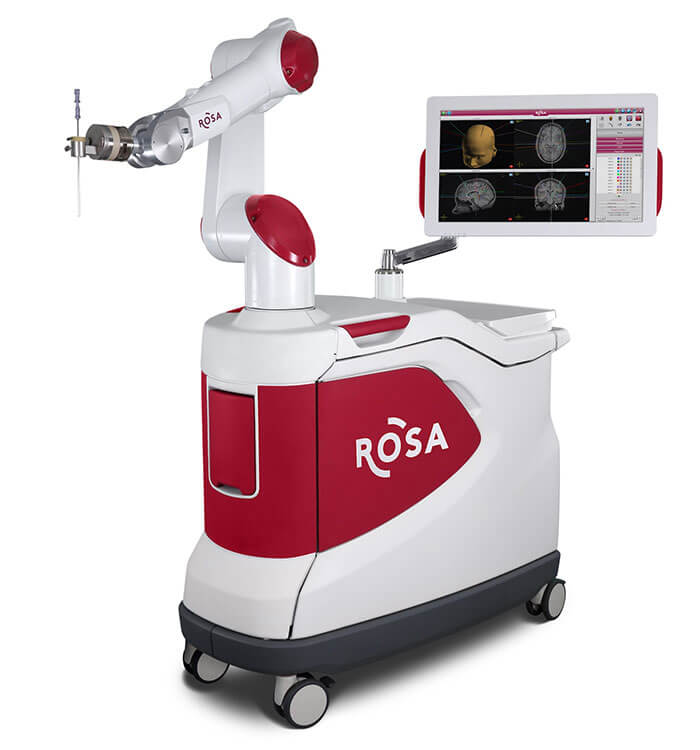New Cranial Robotic System at UH Boosts Quality and Shortens Surgery Times
June 24, 2024
UH Clinical Update | June 2024
Patients undergoing certain types of neurosurgery at UH Cleveland Medical Center now have the added advantage of a cranial robotic system to aid with their procedures, boosting surgical accuracy and shortening procedure times.
 ROSA ONE: Brain System
ROSA ONE: Brain SystemThe ROSA ONE: Brain system, implemented at UH in April, is now being used by UH neurosurgeon Michael Staudt, MD, for stereoelectroencephalography (sEEG) procedures for patients with epilepsy. Dr. Staudt also holds the George R. and Constance P. Lincoln Chair in Brain Health at University Hospitals.
Using ROSA’s main capability, Dr. Staudt is now able to more quickly and accurately implant tiny electrodes – less than a millimeter in diameter -- in the patient’s brain to better localize the location of seizure focus. Dr. Staudt is also using ROSA to aid with laser interstitial thermal therapy (LITT) procedures to address deep-seated tumors or provide minimally invasive treatments for epilepsy.
Improved accuracy and shorter procedure times are the main advantages of the new robotic system, Dr. Staudt says.
“The whole goal of it is to be able to accurately insert things into the brain with around a millimeter or so accuracy,” he says.
This, in turn, helps procedures run more efficiently.
“Take a recent epilepsy case,” he says. “I placed 10 electrodes into the patient’s brain in about 45 minutes, which is remarkably efficient compared to how it was previously done, potentially taking hours.”
Pre-procedure planning with ROSA also shifts. Instead of spending at least a couple of hours placing the patient in a frame, getting a CT scan, positioning and then doing more pre-procedure planning, Dr. Staudt uses ROSA’s software and the patient’s imaging to map out the surgery a week or more in advance.
“I plan the electrode placement ahead of time with the epileptologists, Dr. Staudt says. “I then plan their trajectories.”
When the time for surgery arrives, the process is increasingly efficient.
“The way the workflow exists, I've already done the planning,” he says. “We bring the patient in and affix them to the robot. We obtain an intraoperative O-arm scan, and then we're ready to go within an hour, if not quicker than that. To actually start the operation is quicker, and the actual workflow of the operation is much quicker.”
Next, UH neurosurgeon Jennifer Sweet, MD, Sheila and Sandy Fox Master Clinician in Neurosurgery, is being trained on the ROSA system. Drs. Staudt and Sweet plan to expand its use to deep brain stimulation (DBS) procedures.
“That will be a significant expansion,” he says. “The workflow will be similar to that for epilepsy, but in a different area of the brain and using different electrodes. Traditionally, DBS would be done with a frame and arc system placed on the patient’s head, so ROSA also improves the workflow there.”
DBS surgeries also promise to be significantly shorter thanks to the new cranial robotic system, Dr. Staudt says.
“When I trained, a deep brain simulation surgery was minimum of five or six hours using a frame with awake testing,” he says. “Now we're doing it probably within an hour or an hour and a half, with the patient completely asleep.”


